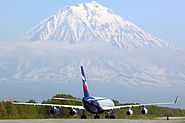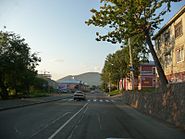| P | ||
|---|---|---|
| Petropavlovsk-Kamchatsky at night | ||
| ||
| Coordinates: 53°01′N 158°39′E / 53.017°N 158.65°E | ||
| Government | ||
| • Head | Sergey Kondrashin | |
| Website | http://pkgo.ru/ | |
Petropavlovsk-Kamchatsky (Russian: Петропа́вловск-Камча́тский) is the city and the administrative, industrial, scientific, and cultural center of Kamchatka Krai, Russia. Population: 179,780 (2010 Census);[1] 198,028 (2002 Census);[2] 268,747 (1989 Census).[3]
Geography[]
The city is situated on high hills and surrounded by volcanoes. In fact, the horizon cannot be seen clearly from any point in town as volcanoes and mountains are everywhere. Across Avacha Bay from the city is Russia's largest submarine base, the Rybachiy Nuclear Submarine Base, established during Soviet times and still used by the Russian Navy.[4] The city is located 6,766 kilometers (4,204 mi) from Moscow (about nine hours by plane) and about 2,220 kilometers (1,380 mi) from Vladivostok.
History[]
Section of Mikhail Tebenkov's 1872 Petropavlovsk harbor chart
The city was founded by Danish navigator Vitus Bering in the service of the Russian Navy. Bering reached Avacha Bay in late 1740 and laid the foundation stone for the harbor town, naming the new settlement "Petropavlovsk" (Peter and Paul) after his two ships, the St. Peter and the St. Paul, built in Okhotsk for his second expedition. The town's location on the sheltered Avacha Bay and at the mouth of the Avacha River saw it develop to become the most important settlement in Kamchatka. It was granted town status on April 9, 1812.
During the 1854–1855 Crimean War, the city was put under siege by the Anglo-French forces, but never fell. The city had been fortified under the command of Nikolay Muravyov-Amursky in the years prior, but only possessed a small garrison of a few hundred soldiers and sixty-seven cannons. After much exchange of fire, 600 allied troops landed south of the city, but were forced to retreat by only 230 Russian troops after heavy fighting. One week later, 900 allied troops landed east of the town, but were again repelled by the Russians. The allied ships then retreated from Russian waters. The total Russian losses were reported at around 100 men; those of the allies at least five times that number.[citation needed]
Petropavlovsk was a great source of fish, particularly salmon, and crab meat for the Soviet Union in the 20th century. Since the end of the Soviet era, fishing rights have also been granted to foreign interests.
Administrative and municipal status[]
Petropavlovsk-Kamchatsky is the administrative center of the krai.[5] Within the framework of administrative divisions, it is incorporated as Petropavlovsk-Kamchatsky City Under Krai Jurisdiction—an administrative unit with the status equal to that of the districts.[5] As a municipal division, Petropavlovsk-Kamchatsky City Under Krai Jurisdiction is incorporated as Petropavlovsk-Kamchatsky Urban Okrug.[6]
Tourism[]
The city has developed a tourist infrastructure. About twenty large tourism companies offer a wide range of services from bear hunting to paragliding. No roads connect the Kamchatka Peninsula to the rest of the world. Travel to Petropavlovsk-Kamchatsky is expensive but is growing in popularity because of the remarkable scenery throughout the peninsula. The city is served by Petropavlovsk-Kamchatsky Airport.
Demographics[]
Ethnic Russians and Ukrainians make up the majority of the population; the city on its own has more inhabitants than the entire neighboring Chukotka Autonomous Okrug or Magadan Oblast.
Climate[]
The climate is boreal (Köppen Dfc) and precipitation averages are estimated at 1,000 millimeters (39 in), or about three-and-a-half times as much as most of Siberia averages, with most falling as snow. Temperatures in winter are much milder than in Siberia—a typical January day averages −5 °C (23 °F), while in summer +15.9 °C (60.6 °F) constitutes an average August high. In warm years monthly high averages in July–August reach +18 °C (64 °F) and higher.[7]
Despite the generally high precipitation, the weather is less cloudy than in the adjacent Kuril Islands that are one of the least sunny places in the world,[8] since the city is located behind a peninsula to the north that blocks some of the fog from the Oyashio Current. Oceanic water in Avacha Bay and adjacent bays is also warmer than coastal waters of Kuril Islands and Okhotsk sea coast (except Southern Kuriles and Southern Sakhalin).
Politics[]
Results of the Russian legislative elections[]
| Parties/Year | 2003 | 2007 | 2011 |
|---|---|---|---|
| Communist Party | 8.83% | 8.89% | 17.78% |
| Patriots of Russia (including former Party of Peace and Unity) |
0.35% | 2.31% | 2.53% |
| A Just Russia (including former Rodina or Motherland-National Patriotic Union Russian Party of Life People's Party of the Russian Federation and Russian Ecological Party "The Greens") |
13.91% | 7.41% | 9.93% |
| Yabloko (including former Union of People for education and research: "Партия СЛОН") |
8.92% | 1.85% | 5.10% |
| Right Cause (including former Citizens' Force Democratic Party of Russia and Union of Rightist Forces) |
4.46% | 2.74% | 0.67% |
| United Russia (including former Agrarian Party of Russia) |
35.29% | 61.78% | 43.59% |
| Liberal Democratic Party | 15.25% | 12.00% | 18.40% |
| Other minor parties | 12.12% |
International relations[]
Twin towns and sister cities[]
Petropavlovsk-Kamchatsky is twinned with:
 Kushiro, Japan (since 1998)[9]
Kushiro, Japan (since 1998)[9] Sevastopol, Ukraine (since 2009)[10]
Sevastopol, Ukraine (since 2009)[10]Unalaska, United States (since 1990)[11]
Gallery[]
References[]
Notes[]
- ↑ Russian Federal State Statistics Service (2011). "Всероссийская перепись населения 2010 года. Том 1" (in Russian). Всероссийская перепись населения 2010 года (2010 All-Russia Population Census). Federal State Statistics Service. http://www.gks.ru/free_doc/new_site/perepis2010/croc/perepis_itogi1612.htm. Retrieved June 29, 2012.
- ↑ Russian Federal State Statistics Service (May 21, 2004). "Численность населения России, субъектов Российской Федерации в составе федеральных округов, районов, городских поселений, сельских населённых пунктов – районных центров и сельских населённых пунктов с населением 3 тысячи и более человек" (in Russian) (XLS). Всероссийская перепись населения 2002 года [All-Russia Population Census of 2002]. http://www.perepis2002.ru/ct/doc/1_TOM_01_04.xls. Retrieved August 9, 2014.
- ↑ Demoscope Weekly (1989). "Всесоюзная перепись населения 1989 г. Численность наличного населения союзных и автономных республик, автономных областей и округов, краёв, областей, районов, городских поселений и сёл-райцентров" (in Russian). Всесоюзная перепись населения 1989 года [All-Union Population Census of 1989]. Институт демографии Национального исследовательского университета: Высшая школа экономики [Institute of Demography at the National Research University: Higher School of Economics]. http://demoscope.ru/weekly/ssp/rus89_reg.php. Retrieved August 9, 2014.
- ↑ [1]
- ↑ 5.0 5.1 Law #46
- ↑ Law #220
- ↑ http://pogoda.ru.net/monitor.php?id=32583&month=8&year=2006 Pogoda.ru.net
- ↑ See Climatological Norms of Simusir Island
- ↑ Russian presence in Japan
- ↑ [2]
- ↑ Alaska - Kamchatka Connections
Sources[]
- Законодательное Собрание Камчатского края. Закон №46 от 29 апреля 2008 г. «Об административно-территориальном устройстве Камчатского края», в ред. Закона №659 от 30 июля 2015 г. «О внесении изменения в статью 5 Закона Камчатского края "Об административно-территориальном устройстве Камчатского края"». Вступил в силу со дня официального опубликования. Опубликован: "Официальные Ведомости", №65-69, 6 мая 2008 г. (Legislative Assembly of Kamchatka Krai. Law #46 of April 29, 2008 On the Administrative-Territorial Structure of Kamchatka Krai, as amended by the Law #659 of July 30, 2015 On Amending Article 5 of the Law of Kamchatka Krai "On the Administrative-Territorial Structure of Kamchatka Krai". Effective as of the day of the official publication.).
- Совет народных депутатов Камчатской области. Закон №220 от 20 октября 2004 г. «О наделении Петропавловск-Камчатского городского муниципального образования статусом городского округа и об установлении границ Петропавловск-Камчатского городского округа». Вступил в силу со дня официального опубликования. Опубликован: "Официальные Ведомости", №77–78, 16 декабря 2004 г. (Council of People's Deputies of Kamchatka Oblast. Law #220 of October 20, 2004 On Granting Urban Okrug Status to Petropavlovsk-Kamchatsky Urban Municipal Formation and on Establishing the Borders of Petropavlovsk-Kamchatsky Urban Okrug. Effective as of the day of the official publication.).
External links[]
- Official website of Petropavlovsk-Kamchatsky (Russian)
- New photos of the city (Russian)
- Photos of Kamchatka (Russian)
- News of Petropavlovsk-Kamchatsky and Kamchatka Krai (Russian)
- Petropavlovsk-Kamchatsky Internet portal (Russian)
- History of the city of Petropavlovsk-Kamchatsky (Russian)
The original article can be found at Petropavlovsk-Kamchatsky and the edit history here.










